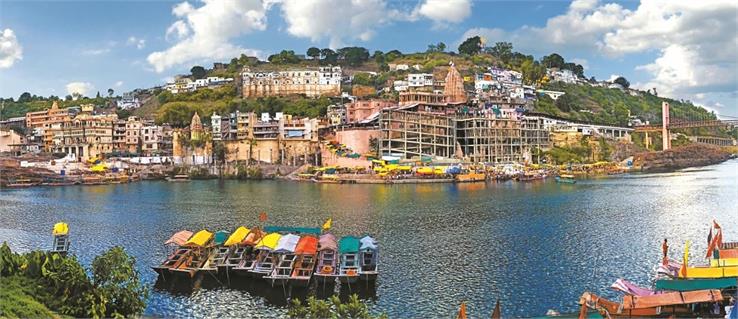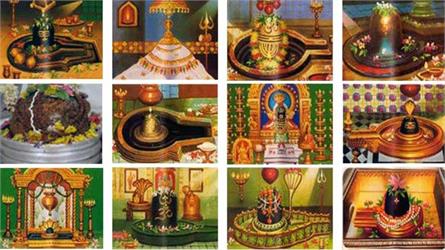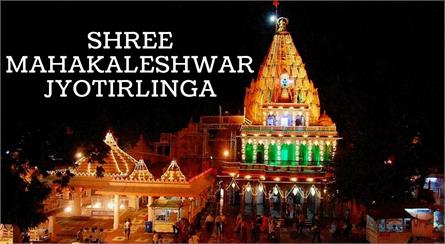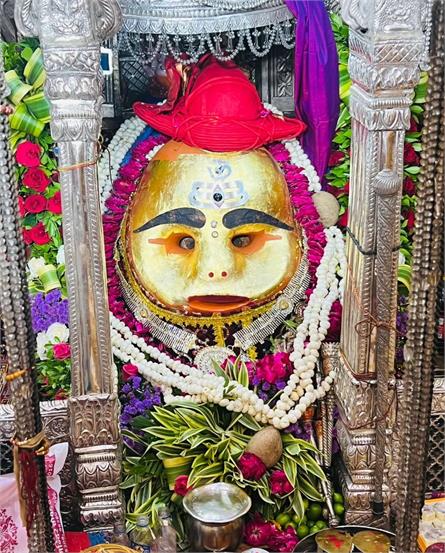Unleash the Divine Powers: Explore the Enchanting Omkareshwar Temple Jyotirlinga!
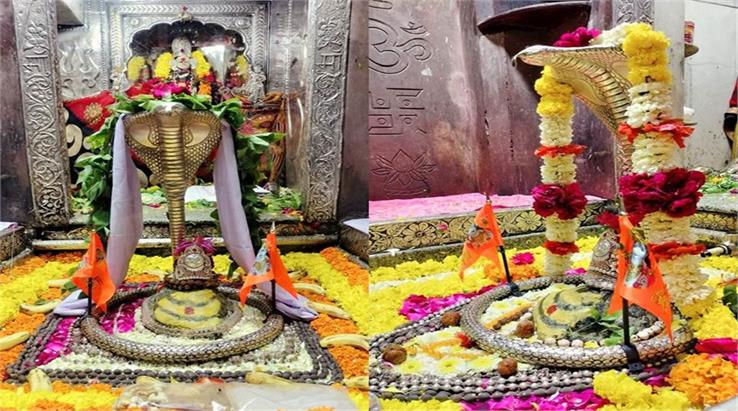
Omkareshwar Temple Jyotirlinga is one of the twelve sacred Jyotirlingas (lingams of light) of Lord Shiva in Hindu mythology. Omkareshwar, which means "Lord of the Om Sound."
Omkareshwar Temple is in Madhya Pradesh on the Narmada River island called Mandhata/Shivapuri. Omkareshwar Temple is revered as an important pilgrimage site for devotees of Lord Shiva. Pilgrims from across the country visit the temple to seek blessings, spiritual enlightenment, and salvation.
The Narmada Parikrama, a circumambulation of the Narmada River, is an ancient pilgrimage that includes visiting the Omkareshwar temple. Devotees undertake this rigorous journey, covering the entire course of the river, as an act of devotion and penance.
Over the centuries, Omkareshwar temple Jyotirlinga has remained an important centre of worship and pilgrimage, attracting countless devotees who seek the divine grace of Lord Shiva. The historical and mythological significance of the Jyotirlinga continues to inspire reverence and devotion among believers.
Also Read: Power of 12 Jyotirlinga, By Which All The Sorrows of Life Go Away
History of Omkareshwar Jyotirlinga
The history of the Omkareshwar temple is deeply rooted in Hindu mythology and has been passed down through ancient texts and oral traditions. While the exact historical timeline is difficult to determine, the significance of the site and the worship of Lord Shiva at Omkareshwar temple is traced back thousands of years.
1. Mythological Origins: According to Hindu legends, the Omkareshwar temple connects to the great churning of the celestial ocean, known as Samudra Manthan. During this event, Devas (celestial beings) and Asuras (demons) joined forces to obtain the nectar of immortality. Numerous divine and valuable items emerged from the ocean as the churning process began.
One of the important items that emerged was a pot of poison (halahala), which could potentially destroy the universe. Lord Shiva came forward to save the world and consumed the poison. To cool down the effects of the poison, Lord Shiva resided on the island of Mandhata in the form of Omkareshwar temple. The island's shape, resembling the sacred symbol "Om," is believed to have manifested due to Lord Shiva's presence.

Also Read: Mahakaleshwar Jyotirlinga: Where Timeless Divinity Meets Mortal Realm
2. Historical References: The historical references to the Omkareshwar temple find in ancient texts and scriptures. The sacredness of the island and the worship of Lord Shiva at Omkareshwar mention in the Skanda Purana, one of the eighteen Mahapuranas of Hinduism. The Purana describes the glory of the Jyotirlinga and the significance of the Narmada River with Lord Shiva.
3. Patronage by Rulers: Throughout history, the Omkareshwar temple has received patronage and support from various rulers and dynasties. Several inscriptions and architectural remains suggest that the temple complex was renovated and expanded by different ruling dynasties, including the Paramaras, Chandelas, Holkars, and Scindias.
The Paramara dynasty, in particular, played a significant role in the development of the temple. King Mandhata, a legendary ruler mentioned in Hindu epics, constructed the original temple at Omkareshwar. The Paramara kings further contributed to the temple's construction and development during their reign.
Omkareshwar Temple Architechture
The main temple of Omkareshwar Jyotirlinga has dedicated to Lord Shiva. It is a beautiful structure built in the Nagara architectural style and exhibits intricate carvings and sculptures. The temple complex consists of two main shrines, Omkareshwar and Amareshwar, representing the two forms of Lord Shiva. The lingam of Omkareshwar is located on the ground floor, while the lingam of Amareshwar is on the upper floor.
The Secret of Omkareshwar Temple
Do you know that the Omkareshwar Jyotirlinga temple conducts a special Shayan Aarti as Lord Shiva comes here every night to rest? It is believed that Lord Shiva plays Chaupar here with Mother Parvati. Surprisingly, the Chaupar is scattered in the morning, which suggests that someone must have played this game at night.
Om-shaped Island
The island of Mandhata, where the Omkareshwar temple is situated, is shaped like the sacred symbol "Om" when viewed from above. This unique formation adds to the spiritual significance of the place and is considered highly auspicious by devotees.
Also Read: Kaal Bhairav Temple Ujjain Where Scientists Fail To Know The Secret
Narmada Parikrama
Omkareshwar is an important stop during the Narmada Parikrama, circumambulating the holy Narmada River. Devotees undertake this pilgrimage to seek blessings and spiritual purification. The route of the Narmada Parikrama passes through Omkareshwar, and many pilgrims visit the Jyotirlinga during their journey.
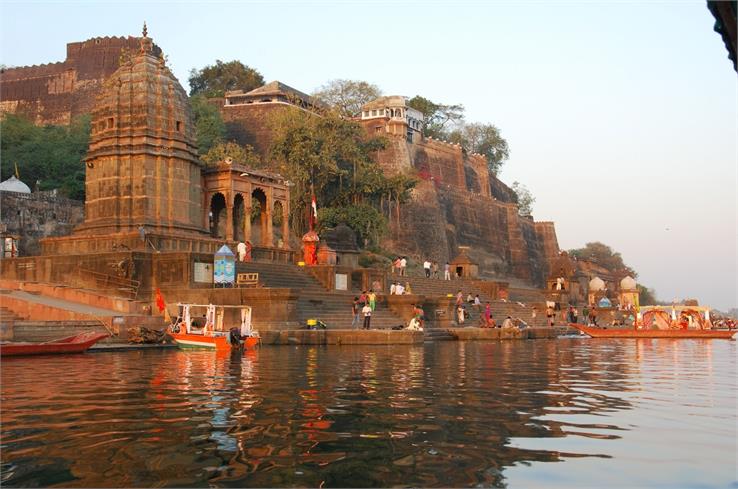
Celebrations and Rituals
Several festivals are celebrated with great enthusiasm at Omkareshwar Jyotirlinga. The most significant one is Mahashivaratri, the night dedicated to Lord Shiva. Devotees from all over the country gather at the temple, offering prayers and participating in religious ceremonies. Festivals like Kartik Purnima, Shravan Maas, and Navratri are also celebrated here.
Spiritual Significance
Omkareshwar Jyotirlinga holds immense spiritual significance for devotees. A visit to this sacred site and sincere worship is believed to grant blessings, remove sins, and bestow spiritual upliftment. The peaceful and serene environment of the island, surrounded by the Narmada River, adds to the spiritual ambience of the place.
Also Read: Best Hotels Near Omkareshwar Temple
Nearby Attractions
Besides the Jyotirlinga temple, Omkareshwar offers other attractions for visitors. The Omkareshwar Dam, constructed on the Narmada River, is a notable site for its scenic beauty.
The other attractions are:
1. The Siddhanath Temple
2. Kajal Rani Cave
3. Satmatrika temples
Best Time To Visit
The best time to visit the Omkareshwar Temple and the surrounding area is during the winter months, from November to February. The weather during this time is pleasant and comfortable, with temperatures ranging from 10°C to 25°C (50°F to 77°F). This temperature makes it ideal for exploring the temple complex and enjoying the scenic beauty of the Narmada River and the surrounding landscape.
Here are a few reasons why winter is considered the best time to visit Omkareshwar Temple:
1. Weather: The winter season offers respite from the scorching summer heat and the monsoon season's humidity. The mild and pleasant temperatures allow visitors to explore the temple and its surroundings comfortably. It is also suitable for outdoor activities and boat rides on the Narmada River.
2. Festivals: Winter is a festive season in India, and several important festivals are celebrated. The most important festival at Omkareshwar Temple is Mahashivaratri, which usually falls in February or March. Devotees from all over the country gather at the temple to offer prayers and participate in the festivities. Witnessing the vibrant celebrations during this auspicious time can be a memorable experience.
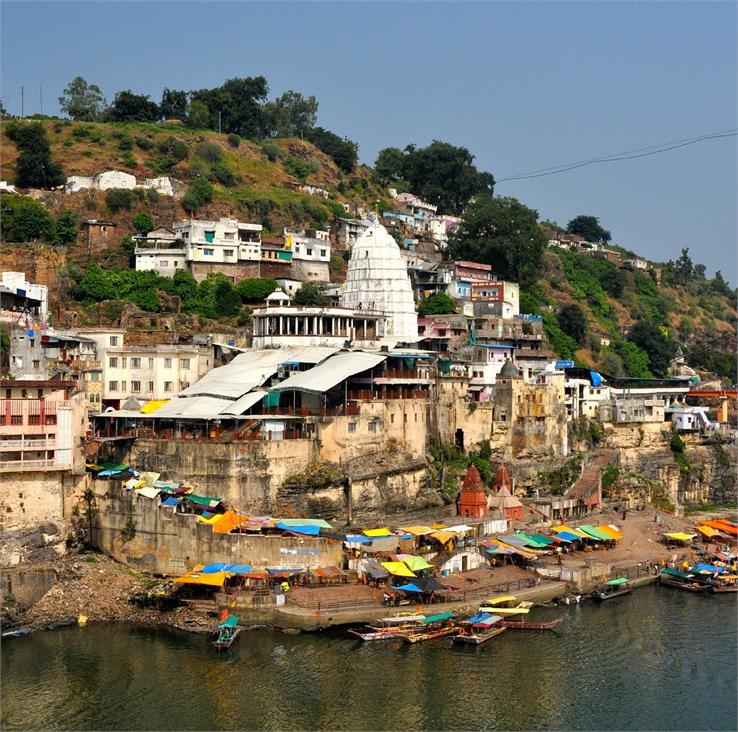
3. Clear Skies: Winter months are characterized by clear skies and minimal rainfall. It provides an excellent opportunity for clear views of the temple, the river, and the surrounding landscape. The Narmada River's serene atmosphere and calm waters create a picturesque setting for visitors.
4. Lesser Crowds: Winter sees fewer crowds than peak pilgrimage seasons, such as during festivals and holidays. It allows visitors to explore the temple complex at their own pace and offers a more peaceful and intimate experience.
However, it's important to note that Omkareshwar Temple remains open throughout the year, and devotees visit the temple during different seasons and festivals based on their personal beliefs and preferences. It's advisable to check the local weather conditions and the timing of major festivals before planning your visit to ensure a comfortable and fulfilling experience.
How To Reach
To reach Omkareshwar Temple, you have several transportation options depending on your starting point. Here are the different modes of transportation to reach Omkareshwar Temple:
1. By Air
The nearest airport to Omkareshwar is Devi Ahilyabai Holkar Airport in Indore, approximately 77 kilometres away. One can book a taxi from the airport or take a bus to Omkareshwar. By Road it takes around 2-3 hours, depending on the traffic conditions.
2. By Train
The nearest railway station to Omkareshwar is Omkareshwar Road Railway Station, located about 12 kilometres away from the temple. However, this station needs more connectivity. The more convenient option is to reach Indore Junction, which is well-connected to major cities across India. From Indore Junction, you can hire a taxi or take a bus to Omkareshwar, which is around a 3-hour journey.
3. By Road
Omkareshwar is well-connected by Road, and there are regular bus services from nearby cities like Indore, Khandwa, Ujjain, and Bhopal. One can take a state transport bus or hire a taxi from these cities to reach Omkareshwar.
If you drive your vehicle, you can follow National Highway 3 (NH3) or State Highway 18 (SH18) to reach Omkareshwar. There are parking facilities available near the temple complex.
4. By Boat
Since Omkareshwar is on an island, you can also reach the temple by a boat ride across the Narmada River. Boats are available from the ghats (riverbanks) near Omkareshwar. The boat ride here offers a scenic view of the river and adds to the overall experience of visiting the temple.
Once you reach Omkareshwar, you can get to the temple complex on foot or take a rickshaw from the ghat area. The temple is on the island, and you must cross a bridge to access it.


